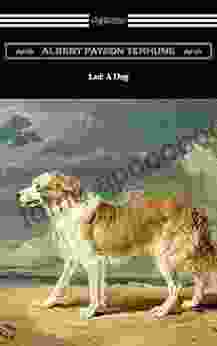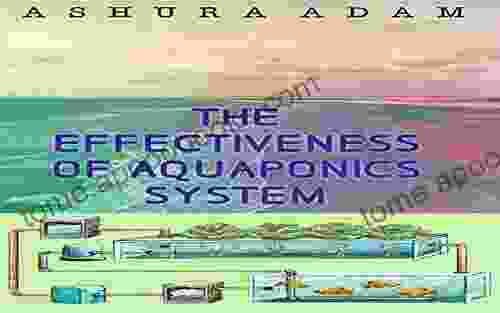The Effectiveness of Aquaponics Systems: A Comprehensive Guide to Sustainable Food Production


4.6 out of 5
| Language | : | English |
| File size | : | 2064 KB |
| Text-to-Speech | : | Enabled |
| Enhanced typesetting | : | Enabled |
| Print length | : | 1081 pages |
| Screen Reader | : | Supported |
:
In a world facing food scarcity and environmental challenges, innovative solutions are imperative. Aquaponics systems have emerged as a promising approach to address these concerns, integrating aquaculture (fish farming) and hydroponics (soilless plant cultivation) to create a sustainable and efficient food production system.
Benefits of Aquaponics Systems:
1. Efficient Resource Utilization:
Aquaponics systems use a closed-loop design where fish waste is converted into nutrients for plants through natural filtration processes. This eliminates the need for chemical fertilizers, reducing environmental impact and production costs.
2. Increased Food Production:
By combining fish and plant production in a single system, aquaponics systems can produce up to 10 times more food per unit area compared to traditional methods, maximizing productivity and space efficiency.
3. Improved Plant Growth:
The nutrient-rich water provided by the fish provides optimal conditions for plant growth. Plants absorb essential nutrients, resulting in increased yields and reduced susceptibility to pests and diseases.
4. Water Conservation:
Aquaponics systems use recirculating water, significantly reducing water consumption compared to conventional agriculture methods. The water is cleaned and reused, minimizing wastage and preserving this precious resource.
5. Environmental Sustainability:
By eliminating chemical fertilizers and minimizing water consumption, aquaponics systems reduce environmental pollution and contribute to a more sustainable food chain.
Applications of Aquaponics Systems:
1. Commercial Food Production:
Aquaponics systems are being adopted by commercial farmers to produce high-quality fish and vegetables for local and global markets, providing a reliable and sustainable source of fresh produce.
2. Home-Based Farming:
Small-scale aquaponics systems are becoming popular for home use, allowing individuals to grow their own food, reduce waste, and experience the benefits of this sustainable technology.
3. Educational Institutions:
Aquaponics systems are increasingly incorporated into educational programs, serving as valuable tools for teaching students about sustainable agriculture, food production, and environmental science.
4. Community Gardens:
Aquaponics systems can foster community engagement and promote healthy eating habits by providing fresh produce to local neighborhoods and schools, empowering communities to become self-sufficient.
Future of Aquaponics Systems:
The potential of aquaponics systems is vast and continues to be explored. Ongoing research and innovation are pushing the boundaries of this technology, including:
- Optimizing water treatment and filtration techniques
- Developing new fish and plant species suitable for aquaponics
- Integrating artificial intelligence and automation into system management
- Expanding aquaponics to large-scale operations
As aquaponics systems gain recognition and adoption, they have the potential to transform the food production industry and contribute significantly to global food security and sustainability.
:
The effectiveness of aquaponics systems in revolutionizing food production is undeniable. By integrating aquaculture and hydroponics, these systems offer a sustainable and efficient approach to meeting the growing demands for food while minimizing environmental impact. With ongoing innovation and research, aquaponics is poised to play a pivotal role in the future of agriculture, ensuring a secure and sustainable food supply for generations to come.
Embark on your journey to explore the transformative potential of aquaponics systems today, contributing to a brighter and more food-secure future.
4.6 out of 5
| Language | : | English |
| File size | : | 2064 KB |
| Text-to-Speech | : | Enabled |
| Enhanced typesetting | : | Enabled |
| Print length | : | 1081 pages |
| Screen Reader | : | Supported |
Do you want to contribute by writing guest posts on this blog?
Please contact us and send us a resume of previous articles that you have written.
 Book
Book Novel
Novel Page
Page Chapter
Chapter Text
Text Story
Story Genre
Genre Reader
Reader Library
Library Paperback
Paperback E-book
E-book Magazine
Magazine Newspaper
Newspaper Paragraph
Paragraph Sentence
Sentence Bookmark
Bookmark Shelf
Shelf Glossary
Glossary Bibliography
Bibliography Foreword
Foreword Preface
Preface Synopsis
Synopsis Annotation
Annotation Footnote
Footnote Manuscript
Manuscript Scroll
Scroll Codex
Codex Tome
Tome Bestseller
Bestseller Classics
Classics Library card
Library card Narrative
Narrative Biography
Biography Autobiography
Autobiography Memoir
Memoir Reference
Reference Encyclopedia
Encyclopedia Anthea Peries
Anthea Peries Nick Yetto
Nick Yetto Babis Bizas
Babis Bizas Jane Harper
Jane Harper Tiffany Washington
Tiffany Washington Anton Treuer
Anton Treuer Arthur Hervey
Arthur Hervey C P Mitchell
C P Mitchell M Night Shyamalan
M Night Shyamalan Sarah J Maas
Sarah J Maas Kjell Ola Dahl
Kjell Ola Dahl Martin Anderson
Martin Anderson Pat Kennedy
Pat Kennedy Ariel Lawhon
Ariel Lawhon H Terrell Griffin
H Terrell Griffin Anthony Vincent Bruno
Anthony Vincent Bruno Annie Lyons
Annie Lyons Arne Drews
Arne Drews Anthony Summers
Anthony Summers Taylor Downing
Taylor Downing
Light bulbAdvertise smarter! Our strategic ad space ensures maximum exposure. Reserve your spot today!

 Natsume SōsekiUnveiling the Untamed Beauty of Colorado: A Literary Journey to the Sangre de...
Natsume SōsekiUnveiling the Untamed Beauty of Colorado: A Literary Journey to the Sangre de... Cody BlairFollow ·12.4k
Cody BlairFollow ·12.4k Ethan GrayFollow ·3.6k
Ethan GrayFollow ·3.6k Allen GinsbergFollow ·18.7k
Allen GinsbergFollow ·18.7k Al FosterFollow ·15.6k
Al FosterFollow ·15.6k Carl WalkerFollow ·7.2k
Carl WalkerFollow ·7.2k Dwight BellFollow ·12k
Dwight BellFollow ·12k Boris PasternakFollow ·11.1k
Boris PasternakFollow ·11.1k Kurt VonnegutFollow ·19.4k
Kurt VonnegutFollow ·19.4k

 Gabriel Garcia Marquez
Gabriel Garcia MarquezLad Dog Baby Professor: The Perfect Book for Your Child
Lad Dog Baby...

 Fredrick Cox
Fredrick CoxAn Excerpt With Fifty Ways To Help Animals Promo Books:...
: Embracing Animal...

 Kelly Blair
Kelly Blair5th Grade US History: Famous US Authors: Fifth Grade...
Step into a captivating world of historical...

 Natsume Sōseki
Natsume SōsekiKull the Destroyer: A Timeless Tale of Sword and Sorcery
The Creation of a...

 Jim Cox
Jim CoxDas Ist Supertoll: Unlocking the Magic of German for Kids
Immersive Learning with...

 Bruce Snyder
Bruce SnyderUnlock the World of Quilting for Kids: Discover "Quick...
Are you ready to embark on a delightful...
4.6 out of 5
| Language | : | English |
| File size | : | 2064 KB |
| Text-to-Speech | : | Enabled |
| Enhanced typesetting | : | Enabled |
| Print length | : | 1081 pages |
| Screen Reader | : | Supported |










